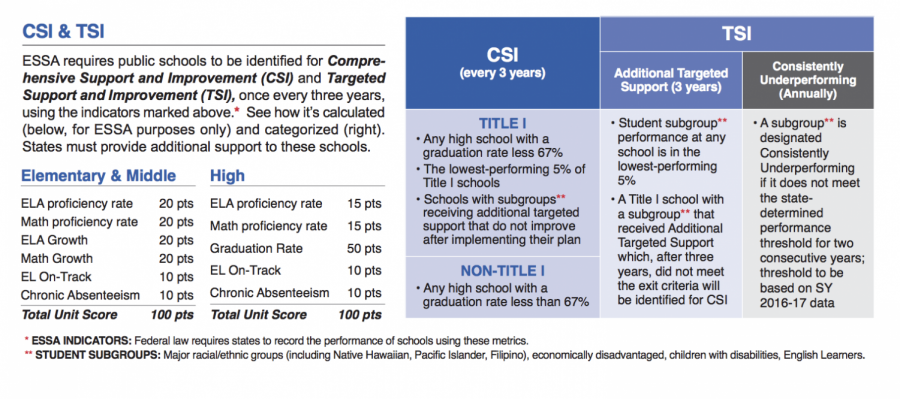CSI to Revive Academic Achievement
With the new year, NHIS is about to get additional support to address areas of instruction and academic achievement.
On September 11, 2017, NHIS was classified as a Comprehensive Support and Improvement (CSI) school. The category was placed on 18 schools across the state. The category will bring not only new changes to the school, but also support and structure from the state and district.
“So basically how they will help us is, number one, there is 3.2 million dollars for 18 CSI schools to access to help fund programs and professional development. We had to come up with a plan on how we would be addressing the areas of instruction and academic achievement and apply for monies. Also, the Complex Area Superintendent and her staff now have input into how we will be addressing our instructional need areas,” said CSI Team Member and WASC FOL Coordinator Robin Kitsu.
NHIS was selected to be a CSI school according to a rubrics created by the Hawaii DOE under the Strive HI accountability system. NHIS will be under the CSI category for three years when at that point scores will be recalculated to evaluate the status of all schools.
“Based on the last Strive HI report, we did not accumulate enough points on the CSI rubric so we were ranked as one of the lowest five percent schools. The reading and the math scores and the ELL English language learner scores were the areas of need,” said Kitsu.
The points that were accounted for were based on the standardized tests that were taken, however even though there was growth, it still was not enough.
“But the irony of it is that our scores did improve from the prior-year. Our math and reading went up but apparently not enough. And our ELL (English Language Learners) actually scored higher than the general education population in math and reading on the SBA assessment,” said Kitsu.
Not only were the standardized test a factor in retrieving points, but it also included other academic tests within the school too.
“What happened was all ELL students took a test called the WIDA test which is very challenging and our scores did not meet the rubrics,” said Kitsu.
The new plan consists of programs and strategies that NHIS has already implemented, and also some new techniques that teachers will learn.
The overall goal of having the CSI plan put upon the school is to see a difference from where the school is now.
“The goal is, of course, to see students performing better, the final outcome is to see students perform better on the standardized test, the SBA. The way to get there, of course, is for you all to have a better experience in the classroom,” said Markus Speidell Instructional Coach.
“That’s where you learn, so the intent is you know to help teachers find strategies or reinforce strategies that they’re already using and figure out how we as a school can tweak what’s going on; create that kind of environment where you guys can learn what’s going on to create that kind of environment where you guys can learn as much as possible.”
According to several teachers and coaches, the school has focused on building relationships over the last few years and now with that in place, will focus on the instruction.
“What I think we’re trying to focus more on the academic side. We’re going to continue the SWAP, (School-wide Argumentative Writing Process), provide more support for teachers. It sounds like the Accelerated Reader is going to continue,” said Kitsu. “But I think it’s more of helping teachers in their instruction, I call it the mechanics of teaching. I think that’s what we’re trying to do. Because programs are just programs. I mean bottom line it comes down to the teachers on how they teach, how they can break down concepts, how they can make the curriculum engaging and that’s the mechanics of teaching.”
The CSI category will push teachers to go back to the basics to provide more structure on the instructional side of the school.
“They’re going to push sort of knowing the curriculum piece. How a class is mapped out from beginning to end. What is going to be taught when and sort of what a course looks like over a year and having that mapped out ahead of time. There’s going to be more focus on aligning courses within a department,” said Speidel.
Not only will teachers be affected by the CSI plan, but the students will see an impact too.
“I think it is the teachers, but it’s for the students. An example would be instead of a teacher just showing a video, the student will know what the learning target is for the day, for the lesson, and how it fits in over the long-term,” said Kitsu.
However, NHIS has had external providers come in to try and help the school in the past, but the success did not sustain—but hopes remain high that this time things will change and last.
“In the past when outside providers come in and try to help, what they were trying to do did not really fit with what we as a school we’re trying to do and so it didn’t really work. I think this time the school is in a better place, I think we grew more as a school; we have a much clearer sense of who we are and what we will become,” said Speidel. “Therefore I think we are in a better place to sort of leverage this kind of opportunity to use them to help us go where we want to. But it really comes down to us to staying true to what we want as well as students, as faculty. And it’s really us pushing where we want to go and letting them figure out where they can fit in and support what we’re already doing.”
Some hope that the CSI plan brings a focused work ethic to the staff to make a change within the school.
“I think a lot of it is just the teachers, it’s pretty much going back to the basics. So, you know we might have some resistance there. But I think we’ve got a good bunch of teachers, I think they understand that there is a need to work, there’s a sense of urgency, but aside from that I think we should be okay,” said Principal Darin Pilialoha.


